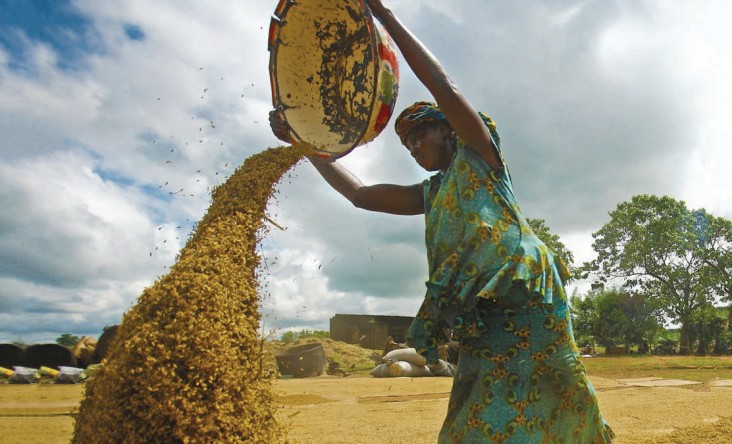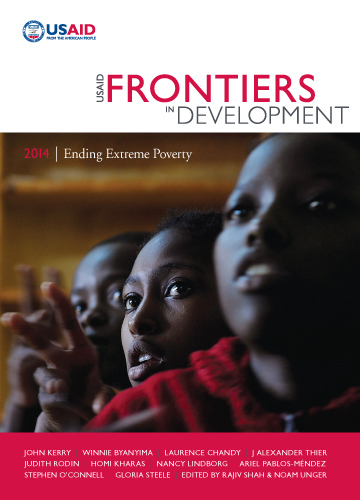Neal Donahue and Ilisa Gertner
When it comes to lifting 1.2 billion people out of extreme poverty by 2030, one thing is certain: It is not going to happen without agricultural growth and greater food security, particularly in sub-Saharan Africa and South Asia. As U.N. Secretary-General Ban Ki-moon recently remarked, “We will not eliminate extreme poverty or achieve sustainable development without adequate food and nutrition for all.”1
With 70 percent of the world’s extreme poor living in rural areas and relying at least partially on agriculture for their livelihoods, agricultural growth is key to raising the incomes of the world’s poor. We know that this growth needs to include smallholders, both male and female, who constitute the majority of those in extreme poverty. We also know that growth needs to be driven by market demands if it is going to be sustainable.
Approaches and best practices for spurring inclusive, market-led agricultural growth, such as the facilitative value chain approach, are well-grounded in research and experience. These approaches are being implemented around the world in various iterations with a good deal of success.2
Our understanding of food security, by contrast, is undergoing something of a revolution. For years, food security was primarily thought of in terms of caloric intake, and development goals centered on boosting agricultural output to ensure an adequate volume of food. Over the past few years, however, research has stressed a greater focus on nutritional intake and the quality and types of foods consumed. In particular, we now know that caloric and nutritional intake—especially for pregnant women and children under the age of 2—can have a lifelong impact on economic potential and quality of life. Recent research has also shown that increased income alone does not necessarily lead to improved nutritional behaviors and reduced malnutrition.3

Agricultural growth initiatives going forward must therefore be designed to boost farmers’ incomes and increase the demand and supply of nutritious food. A frequent challenge in the fight against extreme poverty and food insecurity, however, is the underlying tension between these seemingly complementary goals. The crops farmers produce for self-consumption or for the market may not be the most nutritious, and the market demand for nutritious crops may not be enough to drive supply.
This situation challenges donors and their partners to increase the demand for nutritious foods in ways that make financial sense to the farmers who supply the crops. To accomplish this, donors and partners must understand and address household decisions and behaviors related to purchasing and consuming food.
Inclusive, market-led agricultural growth
For market-driven agricultural growth to lift people out of extreme poverty, it needs to be more inclusive of smallholders, especially women.4 In many poor and food-insecure countries, smallholders’ limited access to resources like technology inputs, finance and information has constrained their yields. Low crop yields limit the availability of food for smallholders’ families and the wider food system. Low yields also constrain farmers’ ability to sell or trade surplus food, which limits their access to available food. If farmers increase their yields and improve the quality of their crops, they can boost their incomes while helping to meet an ever-growing global population’s increased demand for food.5
Nigeria is just one country where we have seen inclusive agricultural productivity through market-driven systems make an impact on poverty. Through the Maximizing Agricultural Revenue and Key Enterprises in Targeted Sites (MARKETS) and Bridge to MARKETS II (BtM2) projects from 2005-2012, USAID and Chemonics International worked through large-scale commercial buyers and agricultural lending banks to help smallholders access training and high-quality inputs, such as seeds and fertilizers.
Not only did the projects’ facilitative value chain approach build stronger relationships between smallholders and buyers, it increased the productivity of rice farmers by an average of 285 percent and generated $614 million in revenue for agribusinesses, farmers and farmer groups. It also increased smallholders’ ability to produce the high-quality long-grain paddy that commands high prices.6
Because the projects worked entirely through market actors, the commercial buyers who initially partnered with smallholders have continued to provide training and high-quality inputs, even after the projects have ended. For example, Olam, one key buyer under MARKETS, is still motivating other rice processors to work more closely with farmers and is interested in pursuing similar activities in other value chains7 BtM2 continued working in these value chains with an expanded partner base—with women constituting 51 percent8 of the participants—and showed $32 million in incremental sales in its first year.
Although evidence-based approaches to inclusive, market-led growth are well established, incremental innovations continue to improve agricultural development. Under a Feed the Future project in Uganda, Chemonics is taking an unconventional approach to strengthening value chains for maize, beans and coffee.
Rather than bypass “middlemen” due to their reputation for squeezing producer margins, which aid programs have been doing for years, we are helping traders and village agents provide farmers with production and marketing services, leading to improved relations and a win-win for all sides. Traders and village agents benefit from higher sales of inputs and crops. Farmers, meanwhile, increase their use of improved seeds, fertilizers and production practices and increase their sales.
To ensure sustainability, we are embedding technical assistance and technology transfer—areas traditionally subsidized by governments and donors—into the business plans and budgets of value chain actors. Within its first year, the project is seeing strong preconditions for sustainability.
Traders sponsored 384 self-financed demonstrations to promote the adoption of improved production technologies and inputs. In the first quarter of 2014, farmers purchased $375,000 worth of improved inputs at prevailing market prices.9
The impact of nutrition
There is a growing consensus that nutrition is one of the best investments for advancing global health and development.10 To address extreme poverty in the decades ahead, nutrition needs to be more fully integrated into agriculture and food security initiatives, with a focus on increasing the demand for nutritious food.
Chemonics has seen the potential impact of integrating nutrition with agricultural growth more widely in food-insecure countries. In Nepal, encouragement of Nepalese farmers to diversify their crops to improve their incomes and their nutrition has led thousands to provide more nutritious foods to their families.11
In northern Nigeria, the MARKETS project piloted an activity related to livelihood and household nutrition to address the nation’s alarming number of malnourished children. The activity, which integrated economic empowerment and nutrition education for 4,000 mothers, was based on the 1,000 Days partnership. This partnership targets action and investment on improving nutrition during the 1,000 days between a woman’s pregnancy and her child’s second birthday.12
An assessment revealed important changes in attitude and behavior. The number of participants who considered nutrition to be the top factor when making food choices for their families rose, from just 4.9 percent to 39 percent, as did the number of women who reported exclusively breastfeeding their babies, from 20 percent to 75 percent.13
Resolving the tension
With so many of the world’s extremely poor dependent on agriculture in sub-Saharan Africa and South Asia, we need to improve farmers’ yields and profits in those regions. As research links nutrition to an individual’s and country’s economic potential, we also need to encourage the consumption of more nutritious foods.
Integrating nutritional education and behavior change activities in agricultural growth programs, as Chemonics has done in Nepal and Nigeria, is a promising step in this direction. As Feed the Future enters into its next phase and the larger development community commits to eradicating extreme poverty by 2030, now is a crucial time for donors and partners to more fully integrate nutrition and agriculture toward improving the lives of people living in poverty.
Neal Donahue is the director for the Middle East region and Ilisa Gertner is the manager for the agriculture and food security practice at Chemonics. The views expressed in this essay are their own and do not necessarily represent the views of the U.S. Agency for International Development or the U.S. Government.
1 http://www.un.org/News/Press/docs/2014/sgsm15827.doc.htm
2 Jeanne Downing, Ruth Campbell and Olaf Kula, “Note from AMAP: Developing a Shared Commitment to the Value Chain Approach,” April 4, 2012, http://www.microlinks.org/learning-marketplace/notes/noteamap-developing-shared-commitment-value-chain-approach. Also see USAID, “Feed the Future Progress Report: Accelerating Progress to End Global Hunger,” May 2014, http://www.feedthefuture.gov/progress. USAID’s Mali Cereal Value Chain project is an example of a successful facilitative value chain approach under the Feed the Future initiative. See http://www.acdivoca.org/site/ID/mali-cereal-value-chain.
3 L. Haddad, H. Alderman, S. Appleton, L. Song and Y. Yohannes, “Reducing Child Malnutrition: How Far Does Income Growth Take Us?” World Bank Economic Review 17 (2003): 107-131.
4 FAO, “Men and Women in Agriculture: Closing the Gap.” http://www.fao.org/sofa/gender/home/en/
5 We are not taking a position on whether land is best used in industrial (e.g., large, specialized and mechanized) farms versus smallholder productivity structures. We do know that smallholders have great efficiency potential and that we cannot have any of these structures be inefficient if we are going to meet global food demands.
6 “Commercializing Nigerian Agriculture: USAID Maximizing Agricultural Revenue and Key Enterprises in Targeted Sites (MARKETS).” Final Report. April 2012. Note that this report incorporates BtM2 results. http://www.chemonics.com/OurImpact/SharingImpact/Documents/Nigeria_MARKETS_Final%20Report.compressed.pdf
7 McNally, Tyler, Jonash R., Patel, H. Greenovate! Companies Innovating to Create a More Sustainable World. IXL Center, Hult International Business School, Imaginatik. p. 76.
8 USAID Maximizing Agricultural Revenue and Key Enterprises in Targeted Sites (MARKETS) II. Quarterly Progress Report. January – March 2014. http://www.chemonics.com/OurImpact/SharingImpact/Documents/Nigeria_MARKETSII_Quarterly%20Report%20Jan%20-%20March%202014.pdf
9 USAID. “Feed the Future Commodity Production and Marketing Activity: Quarterly Performance Report: January-March 2014.” April 2014. http://www.chemonics.com/OurImpact/SharingImpact/Documents/Uganda%20Commodity%20Production%20and%20Marketing%20Activity%20%20QRT%20report%20%20Jan%20-%20Mar%202014.pdf
10 http://www.thousanddays.org/about/
11 USAID, “Strengthening the Foundations for Inclusive Economic Growth: Nepal Economic , Agriculture, and Trade (NEAT) Activity: Final Report,” August 2013, https://dec.usaid.gov
12 For examples of 1,000 Days practices and successes, please refer to: http://www.thousanddays.org/resources/success-stories/
13 USAID MARKETS Livelihood and Household Nutrition Activity Assessment. January 2011. The assessment measured the impact of a pilot activity targeting women from food-insecure households in Northern Nigeria and was designed and rolled out to more than 4,000 participants between June and September 2010. http://www.fsnnetwork.org/sites/default/files/usaid_markets_livelihood_and_nutrition_assessment.pdf
Frontiers in Development
Section 3: Catalyzing Growth and Investment








Comment
Make a general inquiry or suggest an improvement.